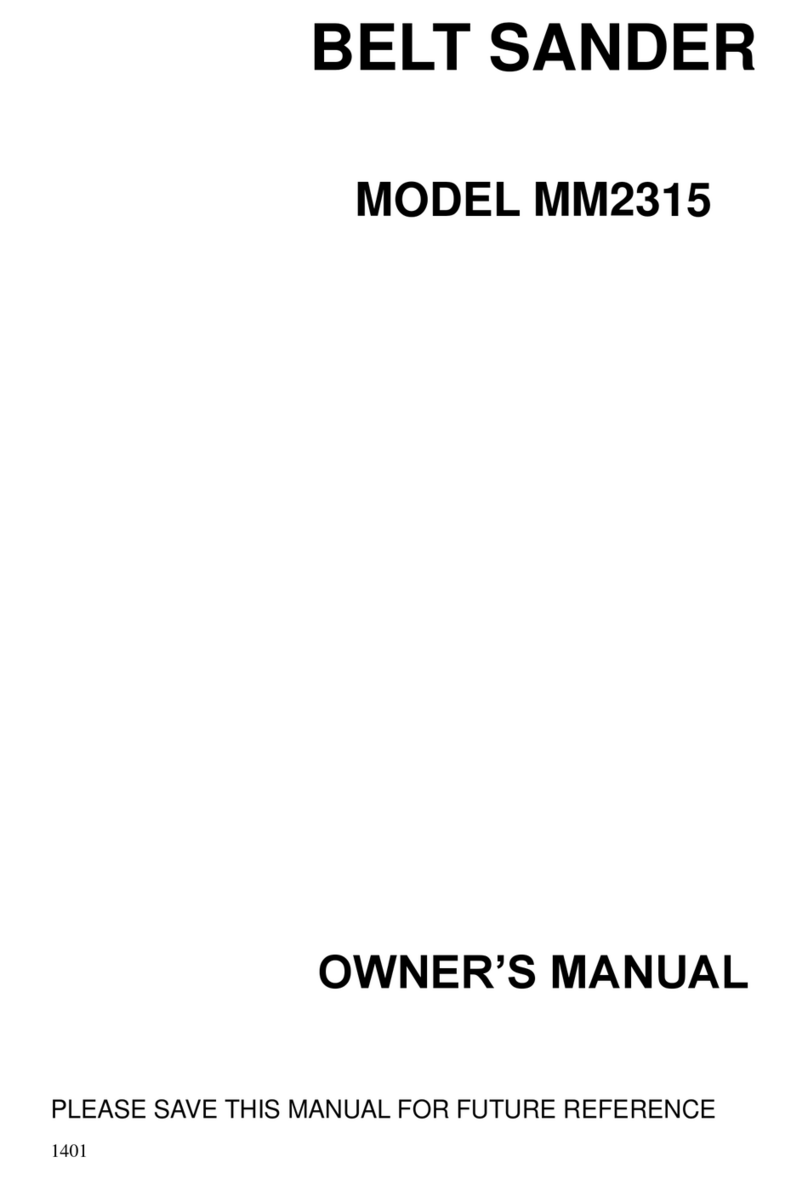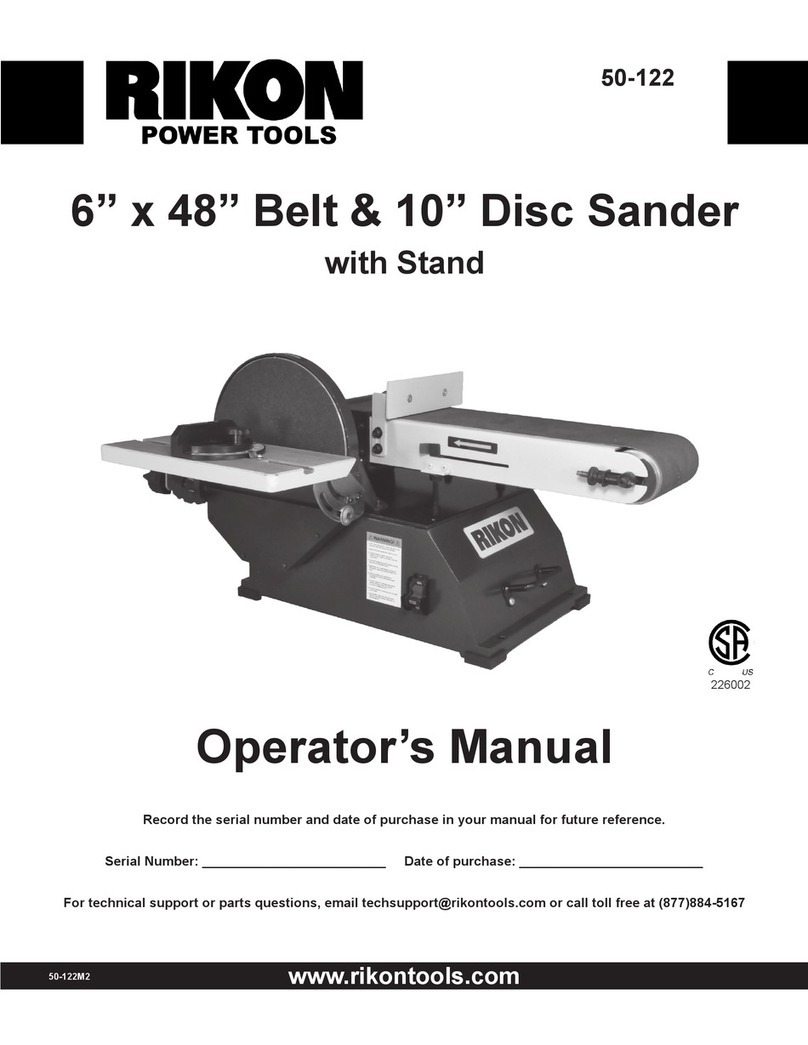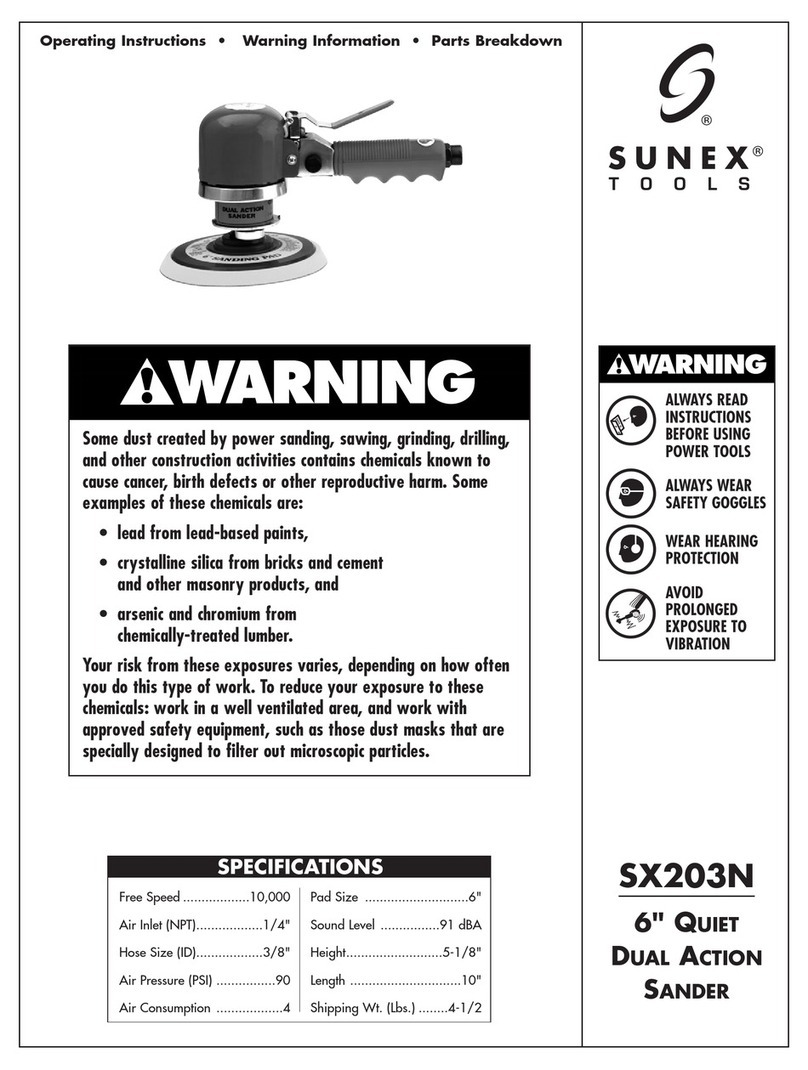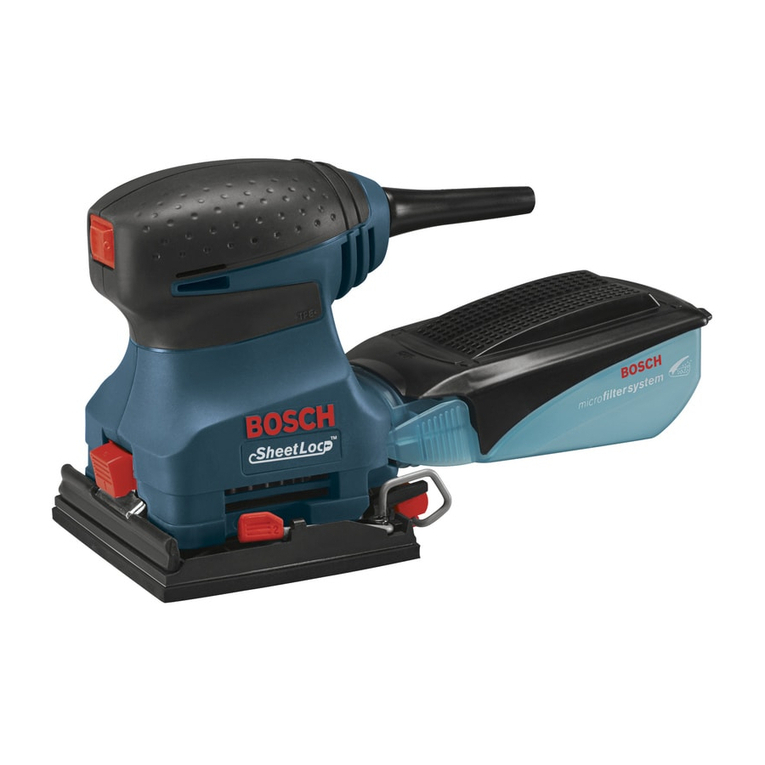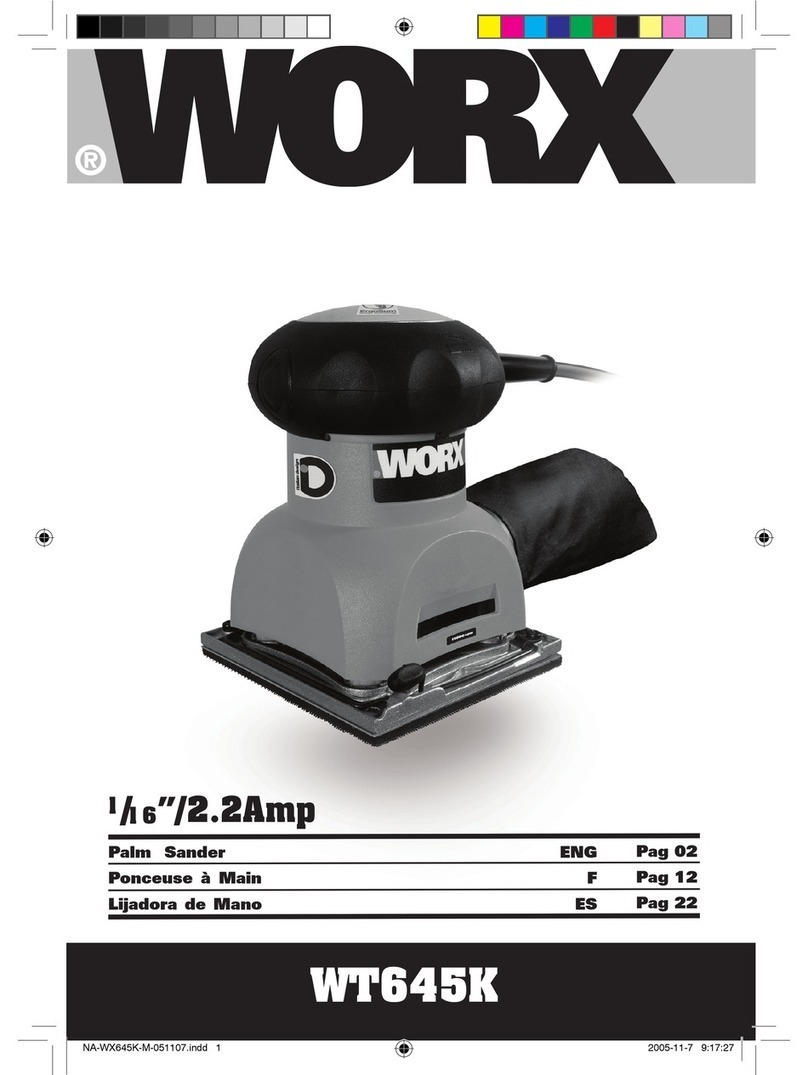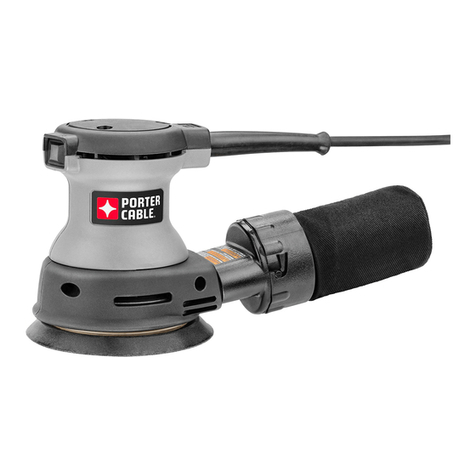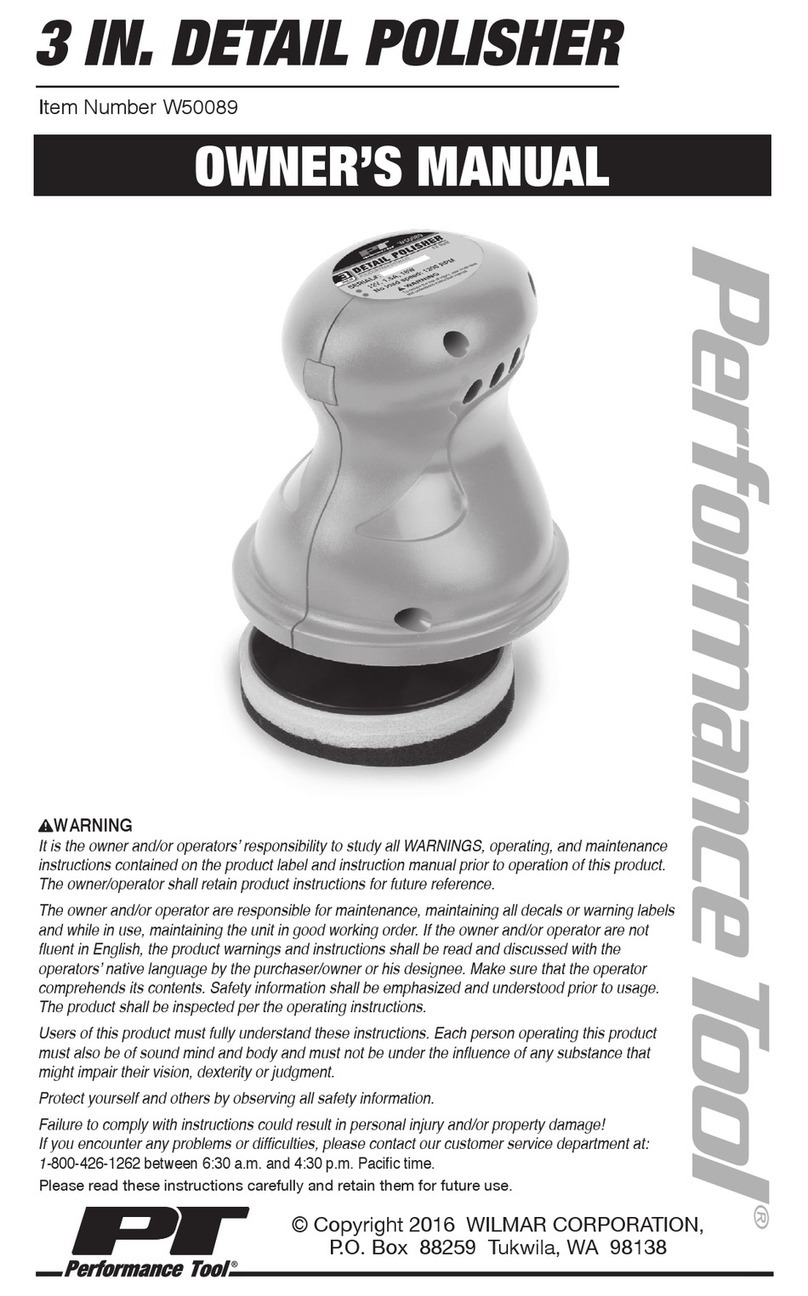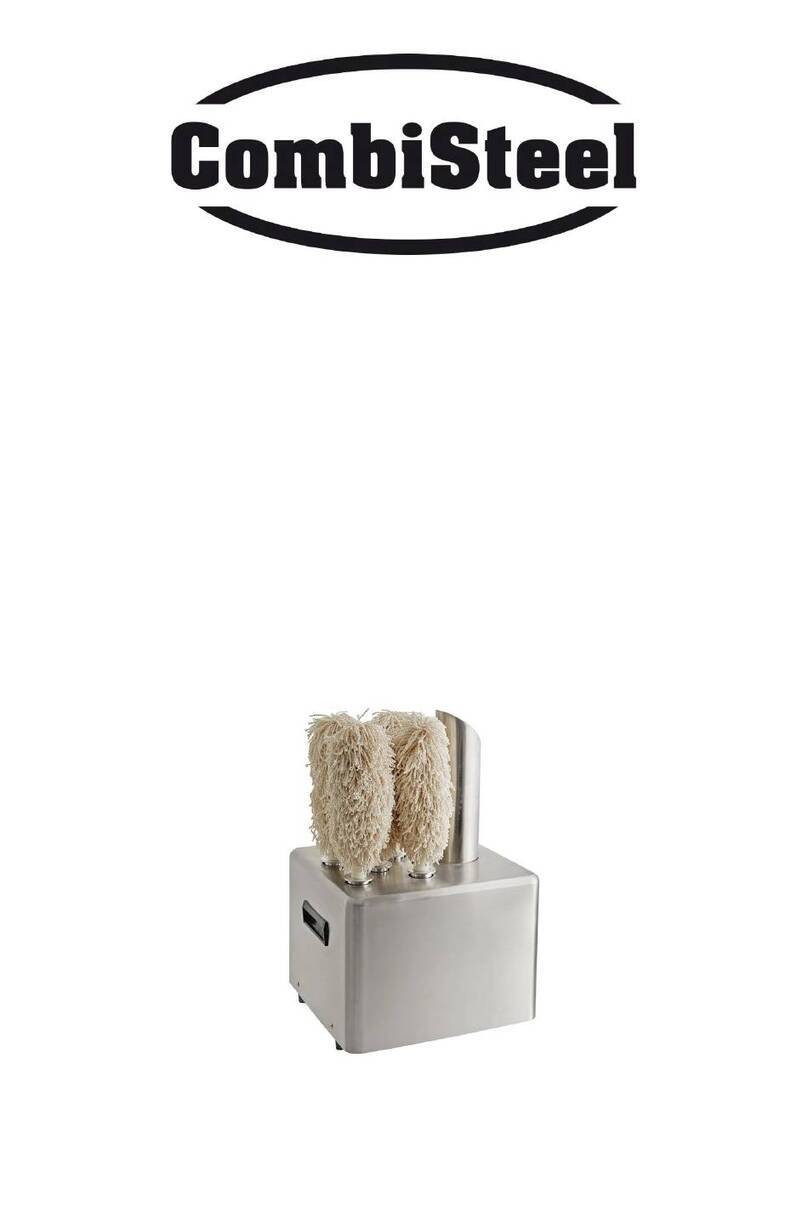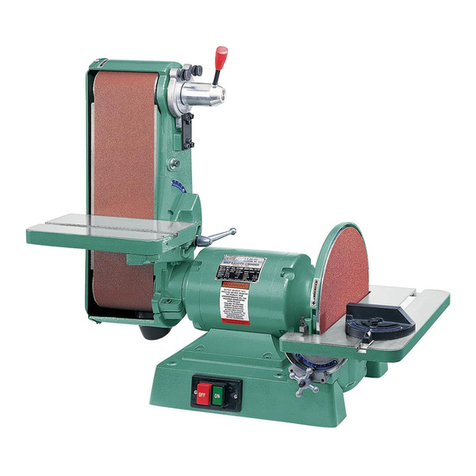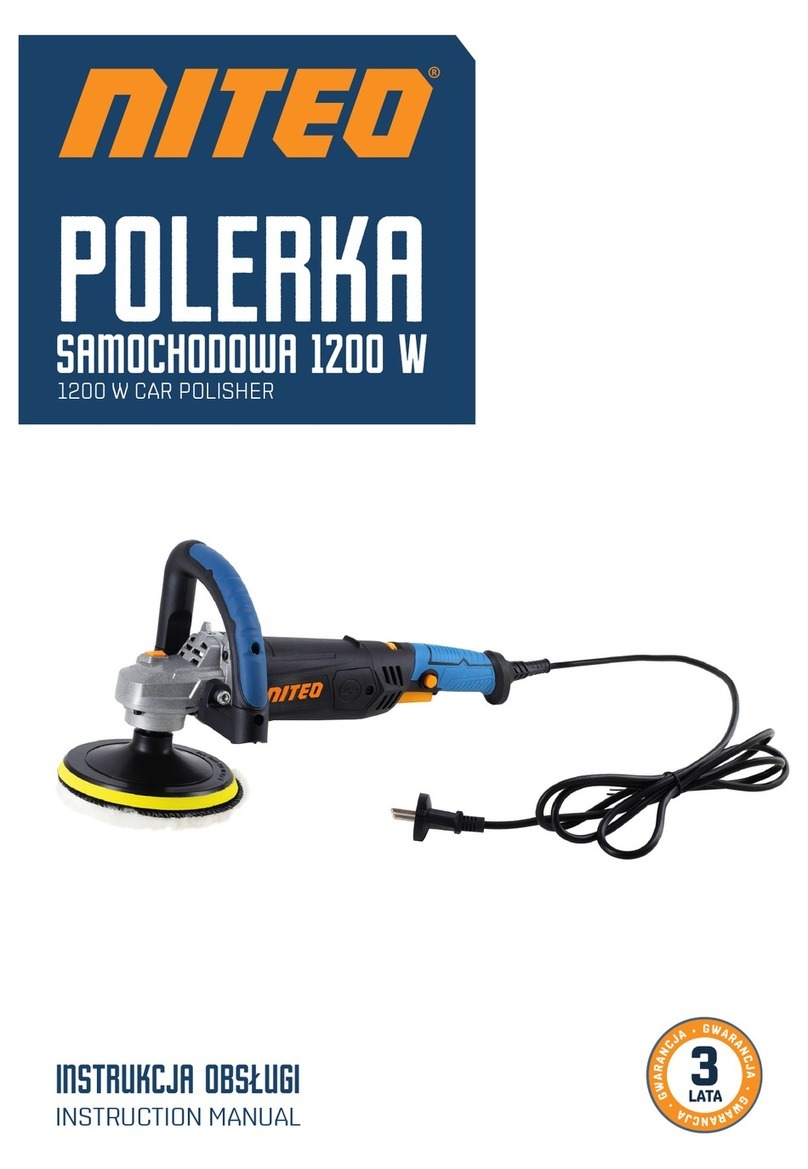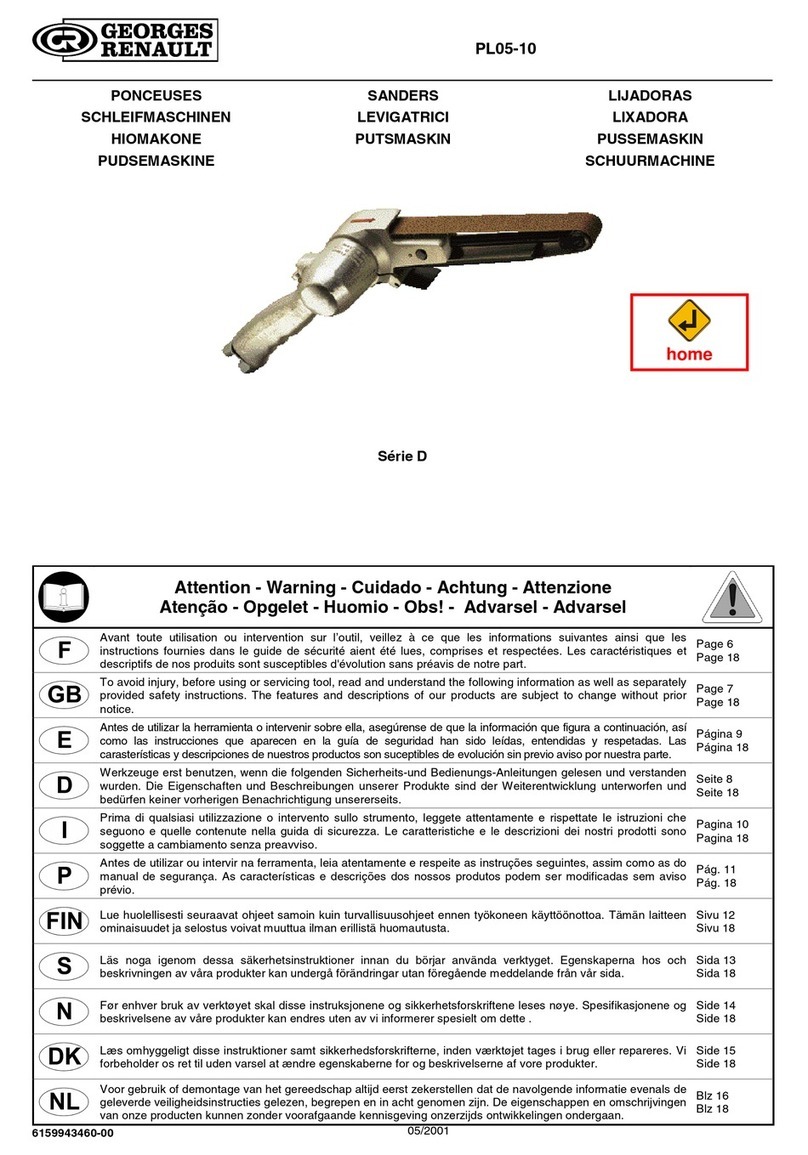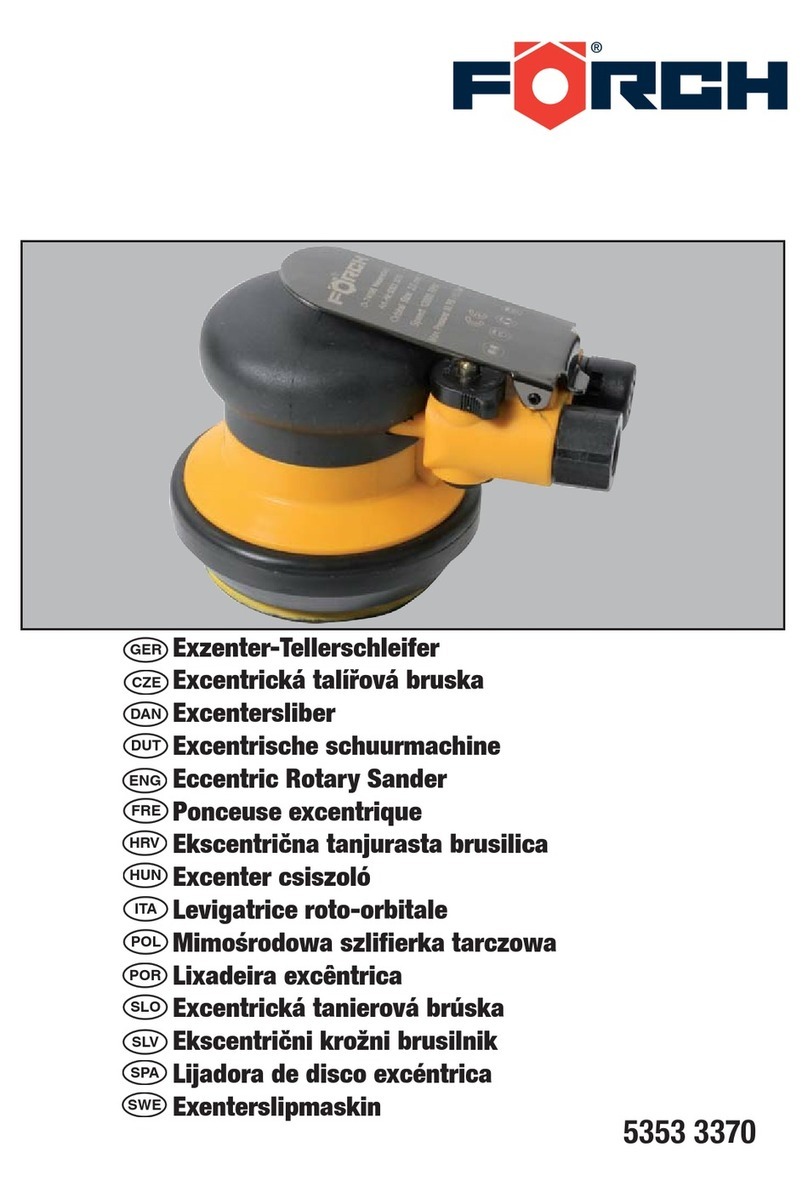Macma BS6X80 User manual

BELT SANDER
MODEL BS6X80(MM2315Q)
OWNER’S MANUAL
PLEASE SAVE THIS MANUAL FOR FUTURE REFERENCE

GENERAL SAFETY RULES FOR POWER TOOLS
1. KNOW YOUR TOOL Read carefully and thoroughly and understand owner’s operating
manual and labels affixed to the tool. Learn its application and limitations as well as
specific potential hazards peculiar to this tool.
2. KEEP GUARDS IN PLACE In working order, and in proper adjustment and alignment.
3. GROUND THE TOOL The tool is equipped with a 3 wire lead, it should always be
plugged into a 3-hole electrical receptacle. Never connect the third (green/yellow or
green) wire to a live terminal.
4. REMOVE ADJUSTING KEYS AND WRENCHES Check to see that keys and adjusting
wrenches are removed from tool before turning them on.
5. KEEP WORK AREA CLEAN Cluttered areas and benches invite accidents. Floor must
not be slipped due to wet or sawdust.
6. AVOID DANGEROUS ENVIRONMENT Do not use power tools in damp or wet locations
or expose them to rain. Keep work areas well lighted. Provide adequate surrounding
work space.
7. KEEP CHILDREN AWAY All visitors should be kept a safe distance from work area.
8. MAKE WORKSHOP CHILD-PROOF With padlocks, master switches, or by removing
starter keys.
9. USE PROPER SPEED This tool will do the job better and safer when operated at the
proper speed.
10. USE RIGHT TOOL Do not force tools or attachment to do a job for which it was not
designed.
11. WEAR PROPER APPAREL Do not wear loose clothing, gloves, neckties or jewelry
(rings, wristwatches) to get caught in moving parts. Non-slip footwear is recommended.
Wear protective hair covering to contain long hair. Roll long sleeves above the elbow.
12. USE SAFETY GOGGLES (HEAD PROTECTION) Wear safety goggles at all times.
Everyday eyeglasses only have impact resistant lenses, they are NOT safety glasses.
Also, use face or dust mask if cutting operation is dusty, and ear protectors (plugs or
muffs) during extended periods or operation.
13. SECURE WORK PROPERLY Use clamps or vise to hold work, when practical. It is
safer than using your hands and it frees both hands to operate tool.
14. DO NOT OVERREACH Keep proper footing and balance at all time.
15. MAINTANIN TOOLS WITH CARE Keep tools sharp and clean for best and safest
performance. Follow instructions for lubricating and changing accessories.
16. DISCONNECT TOOLS Before servicing, when changing accessories or attachments,
disconnect from electricity.
17. USE RECOMMENDED ACCESSORIES Consult the owner’s manual for recommended
accessories. Follow the instructions that accompany the accessories. The use of
improper accessories may cause hazards.
18. AVOID ACCIDENTAL STARTING Make sure switches is in “OFF” position before plug
in.
19. NEVER STAND ON TOOL Serious injury could occur if the tool tips over. Do not store
materials such that it is necessary to stand on the tool to reach them.
20. CHECK DAMAGED PARTS Before further use of the tool, a guard or other part that is
damaged should be carefully checked to ensure that it will operate properly and perform
its intended function. Check for alignment of moving parts, binding or moving parts,
breakage of parts mounting, and any other conditions that may affect its operation. A

guard or other part that is damaged should be properly repaired or replaced.
21. NEVER LEAVE MACHINE RUNNING UNATTENTED Turn power “OFF”. Do not leave
the tool until it comes to a complete stop.
22. DIRECTION OF FEED Always feed the workpiece into the blade against the rotation of
blade or cutters.
23. DRUGS, ALCOHOL AND MEDICATION Never operate tools while under influence of
drugs, alcohol, or after taking medication.
WARNING: For Your Own Safety Read Instruction Manual Before Operating Tool. Wear
Eye Protection. Feed workpiece against rotation of sanding belt. Do not use awkward
hand position. Keep fingers away from revolving sanding belt. Use fixtures when
necessary.
SPECIFICATION:
Belt size………………………………………………………2010mm x 152mm(79” x 6”)
Belt speed………………………………………………………………13M/sec. (43ft/sec.)
Motor speed……………………………………………………………………..…2800RPM
Maximum sanding length……………………………………………..……...790mm(31”)
Round end roller diameter……………………………….…………………70mm(2 3/4”)
Table size: Front table…………… ……………….…790mm x 221mm(31” x 8-3/4”)
Side table ………………………………..514mm x 221mm(20” x 8-3/4”)
Vertical adjusting of front table……………………………..……………….110mm(4”)
Table tilt……………………………………………………………………………45 degree
Table height…………………………………………………..….…………….810mm(32”)
Dust chute diameter..………………………………………………………….100mm(4”)
Stand height……………………………………………………………..…..….600mm(23”)
Net weight…………………………………………………………………….86kgs(190lbs)
Gross weight…………………………………………………………………..90kgs(198lbs)
Packing size(carton)……………………………104cm x 54cm x 41cm(41” x21’ x16”)
The specifications dimensions are not binding. Our firm reserves the right to make
changes for improvement and technical reasons.
ASSEMBLY
Due to packaging requirements, your belt sander is partly assembled. Please do not
operate this belt sander before it is completely assembled and all bolts are completely
secured. The number shown in bracket is the part number.
Please refer to the assembly diagram A (or B if needed) to assembly the belt sander. The
following are the steps to complete the assembly of the belt sander.
Step 1: Assemble the stand. Please note that the short bars(#95) are always ride on the
long bars(96#) and the bolt holes are always aligned.
Step 2: Put the main assembly on the stand and fix it on the stand with 4 bolts(#92) and 4
screws(93).
Step 3: Attach the long (front) table to the Main assembly. Insert the U-bar(#85) into the
two slot on the supporting frame of the table. Then insert the U-bar with the table into the
slots on the main assembly. Both end of the U-bar must be penetrated through the two
holes behind the main assembly. Insert a pin(#84) into the pin hole at each end of the
U-bar.
Step 4: Attach the short(side) table to the Main assembly with the four bolts(#7) and four

screws(#62). Then attach the pointer(#66). The degree label is properly turned in factory,
when the table is at its level position, the pointer must be pointing at 90 degree. If not,
please loose the four bolts(#7) and adjust it.
CHANGING SANDING BELT
To change sanding belt, open the cover (#58),then pull off the bar(#35), loosen the
bolt(#45) that on the dust hood(#44). Turn the tension handle to left(anticlockwise). Take
out the sanding belt and replace with a new one. Recover all steps previously done.
Because the size of a new sanding belt is slightly different from the old one, it may affect
the alignment.
Proper tracking is achieved when drive roller and idler roller are aligned to fit the sander
belt. The knob (#14) is used to tilt the idler roller.
POWER CONNECTIONS
ALLL POWER CONNECTIONS MUST BE DONE BY QUALIFIED EELCTRICIAN. A separate
electrical circuit should be used for the sander. This circuit should not be less that No.12
wire and should be protected with a 15 amperes time lag fuse if three phase current is
applied or a 20 Amperes time lag fuse if single phase current is applied. Before
connecting the motor to the power line, be sure that the electric current is of the same
characteristics as stamped on motor nameplate. All line connections should make good
contact.
If extension cord is allowed according to local codes and ordinances. USE PROPER
EXTENSION CORD. Make sure your extension cord is in good condition. When using an
extension cord, be sure to use heavy enough to carry the current your product will draw.
An undersized cord will cause a drop in line voltage resulting in loss of power and
overheating. The correct cord size to be used depends on cord length and nameplate
ampere rating. If in doubt, consult qualified electric service personnel.
NOTE: RUNNING ON LOWER VOLTAGE OR HIGHER VOLTAGE THAN THE VOLTAGE
THAT THE MOTOR WAS DESIGNED WILL DAMADE THE MOTOR.
DUST COLLECTION
For health and safety reason, using a dust collection system while working with this belt
sander is recommended.

WIRING DIAGRAM 230V/50Hz , 1 PHASE


No.
Description
Q'TY
No.
Description
Q'TY
1
Sticking graphite plate
1
59
Tumbling rod
1
2
Sanding belt
1
60
Limited bolt
2
3
Driven roller
1
61
Bolt M6*25
2
4
Roller adjusting block
1
62
Ring 9
2
5
Screw M6*10
1
63
Washer 12
3
6
Bolt M10*25
1
64
Right support
1
6A
Spring washer 10
19
65
Left support
1
7
Bolt M8*20
1
66
Pointer
1
8
Driven roller stand
1
67
Bolt
2
9
Guide shaft
1
68
Bush
1
10
Spring
1
70
Lock plate
1
11
Retaining ring
1
71
Spacer
1
12
Spring washer 8
5
72
Square box
1
13
Bolt M8*25
1
73
Bolt M8*20
4
14
Roller adjusting knob
1
75
Motor connection plate
1
15
Nut M6
7
76
Screw M6*16
1
15A
Spring washer 6
8
77
Screw M8*40
1
15B
Screw M6*20
2
78
C-key C5*30
1
16
Knob base
1
79
Motor
1
17
Spring
1
80
Lock knob
1
18
Spring retainer
1
81
Table
1
19
Slide
1
83
Handle
6
20
Retaining ring
1
84
Spring roll pin 5*25
4
21
Tension handle
1
85
Table lefting bar
1
22
Elastic roll pin 5*30
1
86
Table pointer
1
23
Elastic roll pin 5*20
1
87
Scale
1
24
Cam
1
88
Handle
1
25
Spring
1
89
Screw M5*6
1
26
Sleeve
1
90
Pointer
1
27
Lock nut M8
20
91
Slide iron
1
28
Big washer 8
14
92
Bolt M6*20
4
29
Square bar
1
94
Support beg
4
30
Sanding table bracket
1
95
Short support
2
31
Screw M6*10
1
96
Long support
2
32
Screw M6*16
2
97
Short cross support
2
32A
Big washer 6
13
98
Long cross support
2
33
Motor roller fixing plate
1
99
Bolt M8*12
32
34
Motor roller
1
100
Nut M8
35
35
Iron block
1
101
Foot
4
35A
Square insert
2
102
Screw M6*20
1
36
Bolt M8*20
2
103
Super washer 6
1
37
Flat washer 8
50
104
PUlley
1
39
Lower support base
1
105
Locking washer 5
6
40
Screw M6*12
4
106
Screw M5*16
6
41
Z-belt L=560
1
107
Low cover for switch
1
42
Pulley cover
1
108
Ring
1
43
Screw M6*45
1
109
Upper cover for switch
1
44
Collector inlet
1
110
Clamp
1
45
Bolt M6*16
1
111
Switch
1
46
Scale
1
112
Screw M4*12
2
52
Extension table
1
113
Plug
1
54
Lock bar
1
114
Screw M4*16
4
56
Nut M6
7
115
Nut M5
6
57
Support stand
1
This manual suits for next models
1
Table of contents
Other Macma Sander manuals
Popular Sander manuals by other brands
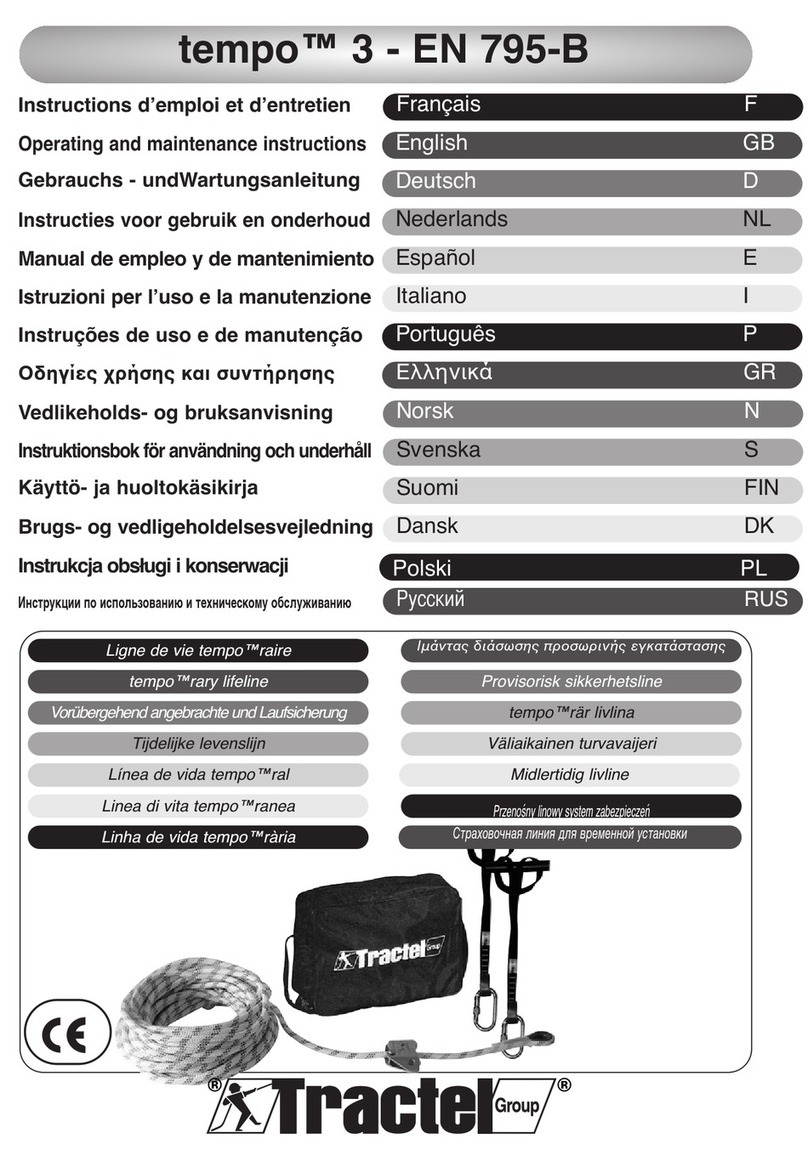
Tractel
Tractel Tempo 3 Operating and maintenance instructions
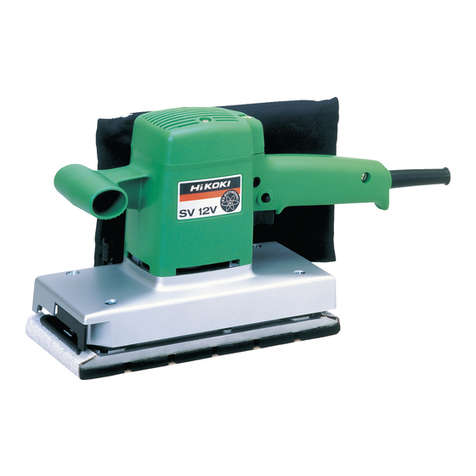
HIKOKI
HIKOKI SV 12V Handling instructions
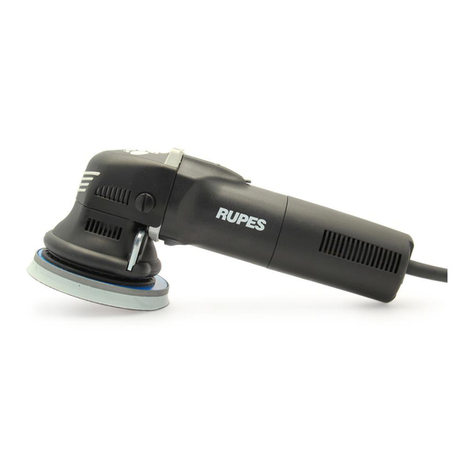
Rupes
Rupes LHR 12E Operating and maintenance instructions
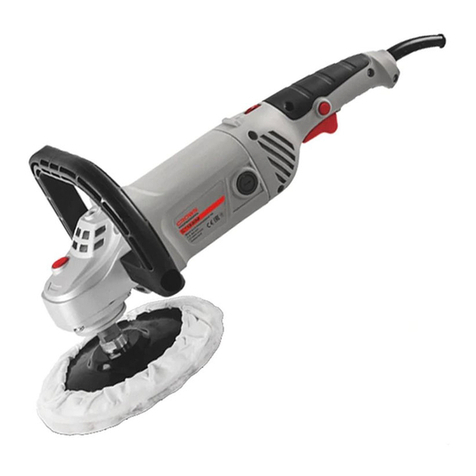
Crown
Crown CT13302 Original instructions

Cmpbell Hausfeld
Cmpbell Hausfeld TL050489 operating instructions

ACDelco
ACDelco ANS603 Product information manual
